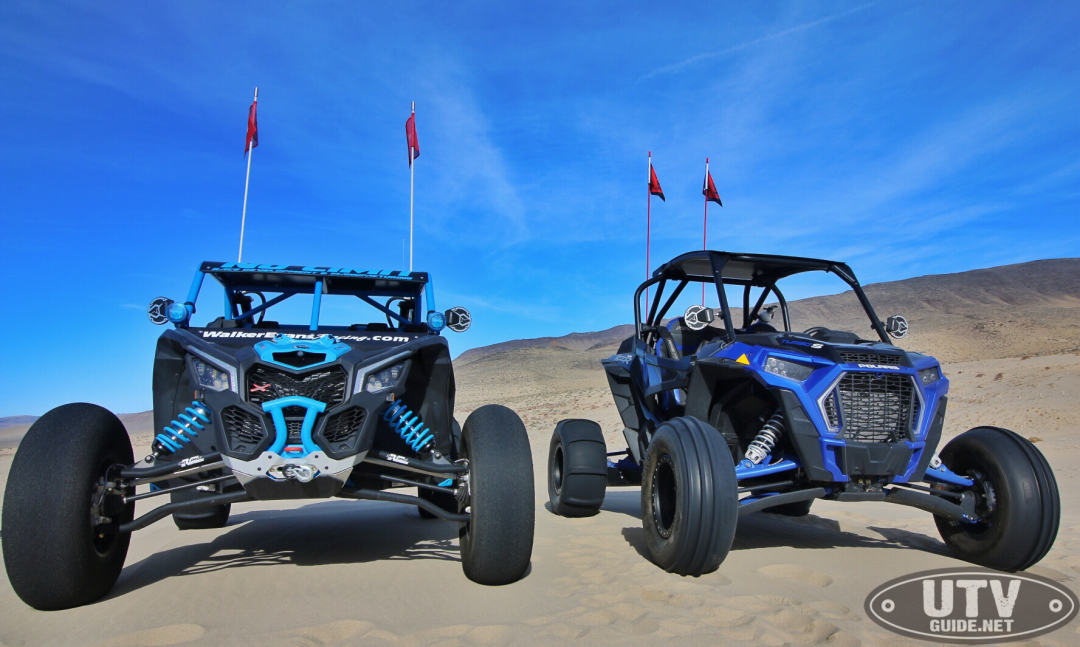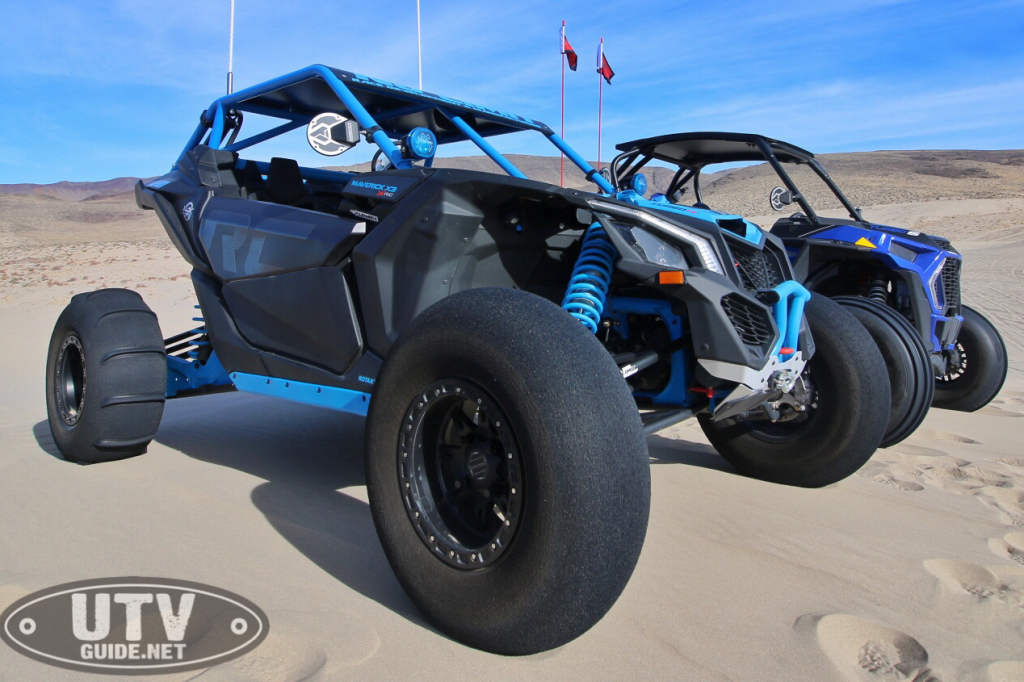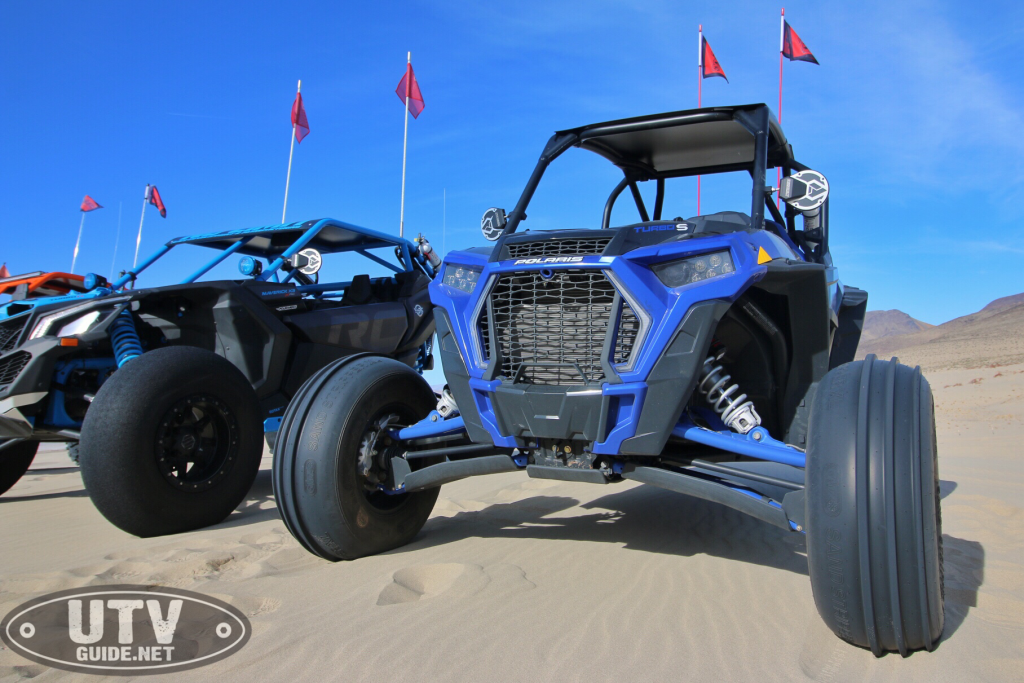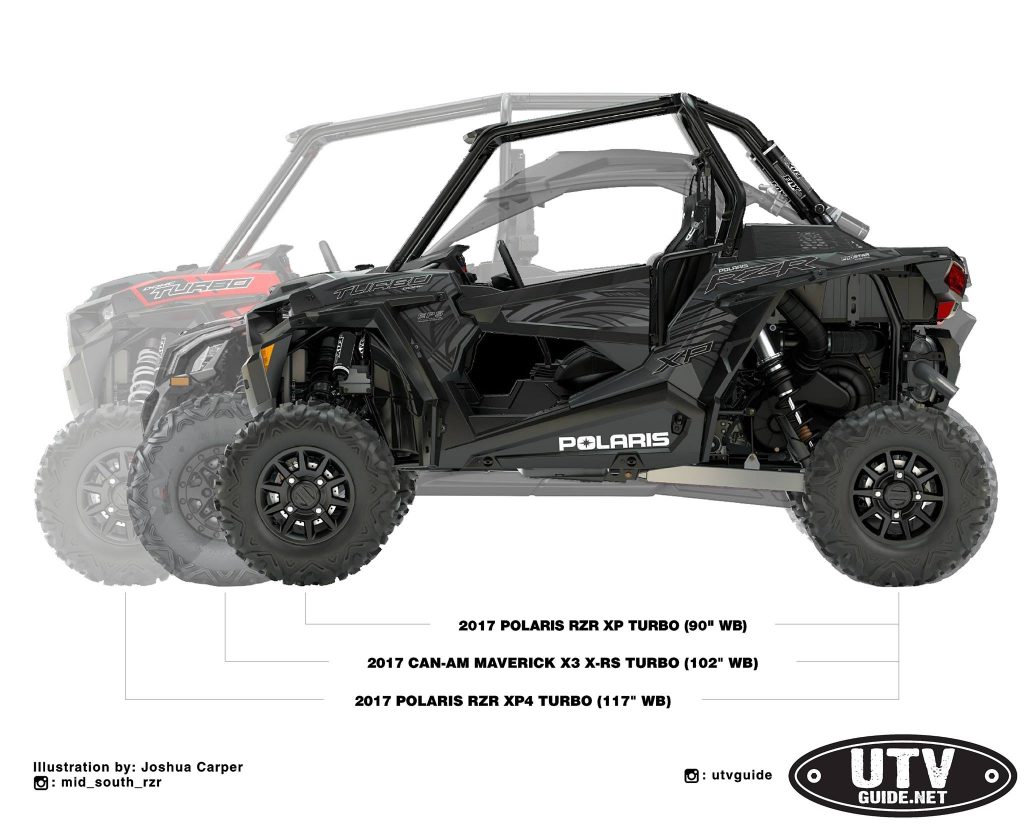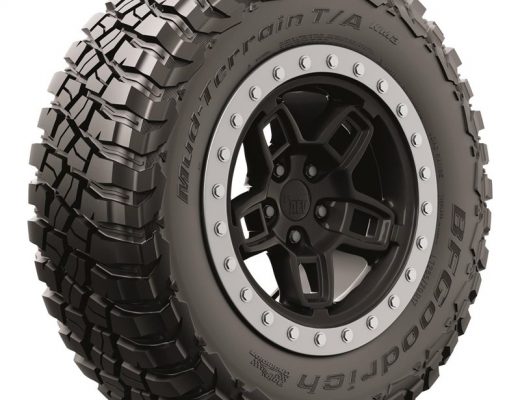By Jon Crowley
We have had a chance to ride the all new Polaris RZR XP Turbo S in the desert a few times. If you haven’t already done so, please take a moment to check out Polaris RZR XP Turbo S First Ride Review. After the media ride, we went right at it and did a full desert comparison – Can-Am Maverick X3 X RC vs. Polaris RZR Turbo S. End result of the desert comparison was that there was no clear winner and a lot of the decision on which is better for the desert comes down to personal preference – legroom, seating position, features and styling are quite different on these machines.
Desert showdown – Can-Am Maverick X3 X RC vs. Polaris RZR Turbo S
For the desert test, our Maverick X3 X RC already had been modified a bit with cage, a-arms, radius links, etc., but we did not feel that these items affected our test. We did swap out the stock 30-inch tires for 32-inch ITP Coyote tires so we would be able to take the tire performance out of the equation. We took a lot of heat for not comparing stock vs. stock, but I am really glad we did the test with the same tires on both vehicles. Part of that decision was selfish in that 32-inch is my preferred tire size for desert riding. My hat is off to Polaris for testing and validating the Turbo S with 32-inch tires right from the factory. Larger tires really affect drivetrain and chassis performance and durability, and knowing that the vehicle went through quality assurance with larger tires is a big deal. I hope other manufacturers will follow suit because tire size continues to grow as performance improves, but durability needs to keep up. It won’t be long until 35-inch tires come standard on a sport UTV.
After our desert comparison was complete, we wanted to compare these two vehicles in the dunes. One of the comments we heard quite a bit from our desert comparison was “why would you use the RC version of the X3?” In my opinion, people aren’t paying attention enough! The RC does everything the RS does with the same 172HP and suspension, but it also has a front differential with more options for locking while rock crawling. It also has a “Trail” mode which we used for desert and dunes while in 4WD.
I have had the X3 in the dunes already once, so check out Can-Am X3 X RC Dune Review and Phase 1 Build, for more specifics.
For our sand dunes comparison, 32-inch dirt tires just don’t cut it so we swapped out for sand tires. And this comes full circle back to the apples-to-apples tire choice for the desert. For the dunes, we did not have equal setups for both vehicles. On the X3 we had 32-inch Skats from Fullerton Sand Sports mounted on HiPer beadlocks. On the Turbo S we had 30-inch GMZ Sand Stripper XLs mounted on Method beadlocks.
The Skats are larger and lighter and the GMZ tires have ribs up front for additional steering input. Both sets of wheels push out the width on the X3 and Turbo S to about 78-inches.
Because of these differences, we did not do a head-to-head drag race up the face of Sand Mountain. And some of the handling characteristics we felt are hard to say if it was because of the tire or the vehicle itself. So I took that all into account.
Polaris RZR XP Turbo S at Sand Mountain
Can-Am Maverick X3 X RC at Sand Mountain
First off, forgive me for not taking more photos and videos. We were at Sand Mountain to have fun, and without some help, it is hard to do it all. Nothing too exciting in the GoPro videos, but it gives you a taste of the vehicles and terrain.
Blasting through the dunes is definitely different than the desert where we did the first test. For my taste, I prefer the lower seating position of the X3 in the dunes. You just feel more sporty and capable of handling rough corners and times when the rear slips out out on you with more confidence. The 72-inch long travel suspension on both vehicles is a big plus for stability.
I also prefer the longer wheelbase of the Can-Am Maverick X3 over the Polaris RZR XP Turbo S in the dunes. I think the X3’s 102-inch wheelbase is just about the perfect setup for the dunes. The Turbo S is a full 12-inches shorter than the X3 and in my opinion feels a bit more twitchy because of it. The Polaris press release for the Turbo S called its wheelbase “flickable” and I think that applies here. In the wide open dunes at Sand Mountain or Glamis I like a longer wheelbase. On some of the tight trails in the Oregon Dunes, the shorter wheelbase of the Turbo S may shine though.
As I mentioned earlier, we did not do a head-to-head drag race with the Turbo S vs. Maverick X3. But what I can tell you is by the seat of my pants, they both have great power out-of-the-box. Sand Mountain, NV sits at over 4,000 feet elevation so we lost a little power over Glamis, but the 168HP in the Turbo S and the 172HP in the Maverick X3 are enough to set you back in your seat and completely roost your friend following too close over a rise.
While both vehicles have great power and suspension, here are some advantages to each vehicles as I see it:
Can-Am Maverick X3 X RC
- 90-inch wheelbase is perfect for dunes
- Lower seating position (feels more sporty and confident)
- Sturdy seats / seat base
- More legroom
- Full doors
Polaris RZR XP Turbo S
- Dynamix Live Valve shock technology with Ride Command
- Great visibility
- Upgraded drivetrain/chassis
- Sparco steering wheel and steering wheel position
At the end of the day, both of these vehicles are big fun and I would be completely happy romping around the dunes in either. It is truly an exciting time to be part of the UTV industry, and it is only going to get better from here!
We will have a set of 32″ Skats from Sandcraft RCR for the Turbo S for our next time in the dunes.

